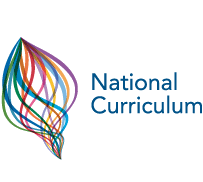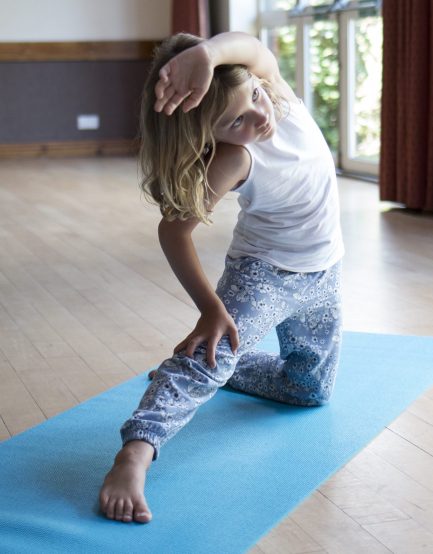Yoga
Calm Skies integrates storytelling, games, music, language, and other arts into a complete curriculum that engages the whole child. Together we weave stories with our bodies and minds in a flow that could only happen in child’s play. We employ ecology, anatomy, nutrition, and life lessons that echo yogic principles of interdependence, oneness, and fun. Most of all, our program engages the entire mind, body, and spirit in a way that honours all the ways children learn.
We can create personalised yoga stories for individual students, groups or schools depending on their needs. It may be that friendship has been an issue in one particular class, we can then create an adventure story based upon friendship and the emotions that may be felt and ways we can overcome some of these challenges. We also provide a program linking to current literature and films as well as general themes. In the safety and familiarity of their school or setting, children go on wild and wonderful journeys as the heroes in their own adventure – and build their strength, balance and confidence in the process. Classes are inclusive and offer a complete form of physical exercise in a safe and non-competitive environment.
Yoga
Calm Skies integrates storytelling, games, music, language, and other arts into a complete curriculum that engages the whole child. Together we weave stories with our bodies and minds in a flow that could only happen in child’s play. We employ ecology, anatomy, nutrition, and life lessons that echo yogic principles of interdependence, oneness, and fun. Most of all, our program engages the entire mind, body, and spirit in a way that honours all the ways children learn.
We can create personalised yoga stories for individual students, groups or schools depending on their needs. It may be that friendship has been an issue in one particular class, we can then create an adventure story based upon friendship and the emotions that may be felt and ways we can overcome some of these challenges. We also provide a program linking to current literature and films as well as general themes. In the safety and familiarity of their school or setting, children go on wild and wonderful journeys as the heroes in their own adventure – and build their strength, balance and confidence in the process. Classes are inclusive and offer a complete form of physical exercise in a safe and non-competitive environment.
The Natural World
See here for our complete range of services we offer.
When yogis developed the asanas many thousands of years ago, they still lived close to the natural world and used animals and plants for inspiration—the sting of a scorpion, the grace of a swan, the grounded stature of a tree. When children imitate the movements and sounds of nature, they have a chance to get inside another being and imagine taking on its qualities. When they assume the pose of the lion (Simhasana) for example, they experience not only the power and behaviour of the lion, but also their own sense of power: when to be aggressive, when to retreat. The physical movements introduce young people to yoga’s true meaning: union, expression, and honour for oneself and one’s part in the delicate web of life.
The Natural World
When yogis developed the asanas many thousands of years ago, they still lived close to the natural world and used animals and plants for inspiration—the sting of a scorpion, the grace of a swan, the grounded stature of a tree. When children imitate the movements and sounds of nature, they have a chance to get inside another being and imagine taking on its qualities. When they assume the pose of the lion (Simhasana) for example, they experience not only the power and behaviour of the lion, but also their own sense of power: when to be aggressive, when to retreat. The physical movements introduce young people to yoga’s true meaning: union, expression, and honour for oneself and one’s part in the delicate web of life.
See here for our complete range of services we offer.
What is Yoga?
Yoga has been around for thousands of years. Yoga is a practice that started in India and is now very popular in the U.K. and around the world. It has gained a lot of attention lately — perhaps as it is a fun and easy way for both adults and kids to feel healthy and happy.
The word “yoga” means “union” in Sanskrit, the ancient language of India. Quite simply, yoga is the “union” or coming together of mind (thoughts and feelings) and physical body. Many people feel an overall sense of well-being when they practice yoga.
There are many aspects to yoga. In short, yoga is a system of physical exercises or postures (called asanas). These asanas build strength, flexibility and confidence. Yoga is also about breathing (called pranayama), which helps calm and refresh the body and mind.
What is yoga?
Yoga has been around for thousands of years. Yoga is a practice that started in India and is now very popular in the U.K. and around the world. It has gained a lot of attention lately — perhaps as it is a fun and easy way for both adults and kids to feel healthy and happy.
The word “yoga” means “union” in Sanskrit, the ancient language of India. Quite simply, yoga is the “union” or coming together of mind (thoughts and feelings) and physical body. Many people feel an overall sense of well-being when they practice yoga.
There are many aspects to yoga. In short, yoga is a system of physical exercises or postures (called asanas). These asanas build strength, flexibility and confidence. Yoga is also about breathing (called pranayama), which helps calm and refresh the body and mind.
Why Yoga?
Children gain enormous benefits from practising yoga. Through yoga, children are able to exercise, play, connect more deeply with their inner self and develop an intimate relationship with the natural world that surrounds them. Yoga brings that marvellous inner light that all children have, to the surface.

Mental benefits
- Increases attention span
- Improves concentration
- Compassion and empathy
- Improves memory retention and learning ability
- Increases self-confidence
- Encourages self-expression
- Lowers anxiety and stress
- Supports curriculum learning
- Improves relationships and social awareness
- Encourages healthy sleep patterns
- Encourages a positive outlook
- Sense of calmness

Physical benefits
- Strength
- Posture
- Overall physical fitness
- Flexibility
- Strong bones
- Balance and coordination
- Positive body image
- Balances energy levels and calms the nervous system
- Develops sensory awareness
- Inclusive and non-competitive
- Improves the digestive system
- A reduced risk of injury in sports and games with better overall fitness and coordination

Mental benefits
- Increases attention span
- Improves concentration
- Compassion and empathy
- Improves memory retention and learning ability
- Increases self-confidence
- Encourages self-expression
- Lowers anxiety and stress
- Supports curriculum learning
- Improves relationships and social awareness
- Encourages healthy sleep patterns
- Encourages a positive outlook
- Sense of calmness

Physical benefits
- Strength
- Posture
- Overall physical fitness
- Flexibility
- Strong bones
- Balance and coordination
- Positive body image
- Balances energy levels and calms the nervous system
- Develops sensory awareness
- Inclusive and non-competitive
- Improves the digestive system
- A reduced risk of injury in sports and games with better overall fitness and coordination
EYFS
Learn More
National Curriculum
Learn More

EYFS Links for Calm Skies Yoga
- Communication and language development involves giving children opportunities to experience a rich language environment; to develop their confidence and skills in expressing themselves; and to speak and listen in a range of situations.
- Physical development involves providing opportunities for young children to be active and interactive; and to develop their co-ordination, control, and movement. Children must also be helped to understand the importance of physical activity, and to make healthy choices in relation to food.
- Personal, social and emotional development involves helping children to develop a positive sense of themselves, and others; to form positive relationships and develop respect for others; to develop social skills and learn how to manage their feelings; to understand appropriate behaviour in groups; and to have confidence in their own abilities.
- Understanding the world involves guiding children to make sense of their physical world and their community through opportunities to explore, observe and find out about people, places, technology and the environment.
- Expressive arts and design involves enabling children to explore and play with a wide range of media and materials, as well as providing opportunities and encouragement for sharing their thoughts, ideas and feelings through a variety of activities in art, music, movement, dance, role-play, and design and technology.

National Curriculum Links for Calm Skies Yoga
KS1, KS2, KS3, KS4 – PSHE
Relationships, healthy lifestyle, physical activity, body image, mental health, self-esteem, personal and emotional well-being.
Key stage 1
- Develop fundamental movement skills, become increasingly competent and confident and access a broad range of opportunities to extend their agility, balance and coordination, individually and with others.
- Master basic as well as developing balance, agility and co-ordination, and begin to apply these in a range of activities
- Perform dances using simple movement patterns.
Key stage 2
- Continue to apply and develop a broader range of skills, learning how to use them in different ways and to link them to make actions and sequences of movement. They should enjoy communicating and collaborating with each other. They should develop an understanding of how to improve in different physical activities and sports and learn how to evaluate and recognise their own success.
- Develop flexibility, strength, technique, control and balance, perform dances using a range of movement.
EYFS

EYFS Links for Calm Skies Yoga
- Communication and language development involves giving children opportunities to experience a rich language environment; to develop their confidence and skills in expressing themselves; and to speak and listen in a range of situations.
- Physical development involves providing opportunities for young children to be active and interactive; and to develop their co-ordination, control, and movement. Children must also be helped to understand the importance of physical activity, and to make healthy choices in relation to food.
- Personal, social and emotional development involves helping children to develop a positive sense of themselves, and others; to form positive relationships and develop respect for others; to develop social skills and learn how to manage their feelings; to understand appropriate behaviour in groups; and to have confidence in their own abilities.
- Understanding the world involves guiding children to make sense of their physical world and their community through opportunities to explore, observe and find out about people, places, technology and the environment.
- Expressive arts and design involves enabling children to explore and play with a wide range of media and materials, as well as providing opportunities and encouragement for sharing their thoughts, ideas and feelings through a variety of activities in art, music, movement, dance, role-play, and design and technology.
National Curriculum

National Curriculum Links for Calm Skies Yoga
KS1, KS2, KS3, KS4 – PSHE
Relationships, healthy lifestyle, physical activity, body image, mental health, self-esteem, personal and emotional well-being.
Key stage 1
- Develop fundamental movement skills, become increasingly competent and confident and access a broad range of opportunities to extend their agility, balance and coordination, individually and with others.
- Master basic as well as developing balance, agility and
co-ordination , and begin to apply these in a range of activities - Perform dances using simple movement patterns.
Key stage 2
- Continue to apply and develop a broader range of skills, learning how to use them in different ways and to link them to make actions and sequences of movement. They should enjoy communicating and collaborating with each other. They should develop an understanding of how to improve in different physical activities and sports and learn how to evaluate and recognise their own success.
- Develop flexibility, strength, technique, control and balance, perform dances using a range of movement.
The Science Bit
So you think yoga is just about laying on mats, humming in the corner and hoping you will feel ‘relaxed’? Well, modern-day science confirms that the practice of yoga has tangible physical health benefits that include improved brain function and denser bones, as well as immune health, improved nervous system functioning and strength. Through the practice of yoga, you can enjoy the benefits of a strong body, calm mind, increased happiness and reduced stress. At Calm Skies, we truly believe in the science behind practice.
Yoga instructor and physician, Dr Loren Fishman uses yoga in his medical practice to treat conditions such as multiple sclerosis, arthritis and others. Yoga boosts brain chemicals that promote a sense of wellbeing, it increases the levels of the brain chemicals like GABA, serotonin, and dopamine, the happy chemicals responsible for feelings of relaxation and contentment. These neurotransmitters are targeted by the drugs for medicating mood, such as anti-depressants and anti-anxiety drugs. Yet yoga has long been shown to successfully reduce and heal anxiety and depression.
Dr. Tiffany Field, a leading authority on touch, Director of the Touch Research Institute at the University of Miami, shows how yoga has wonderful benefits on anxiety and depression, pain, cardiovascular, autoimmune and immune conditions and on pregnancy and has written a book collating a variety of research on the benefits of yoga.
Yoga is so popular and fundamental to so many people’s lives and wellbeing, that there is now an annual World Yoga Day which is recognised by the United Nations. The potent day of the solstice, June 21, marks the day of celebration for this remarkable ancient practice that enhances the lives of so many across the globe.
%
of students practising yoga weekly showed a positive change in ability and focus.
%
of students practising weekly yoga displayed a positive change in empathy and awareness.
%
of students said they enjoyed Cosmic Kids Yoga sessions.
%



